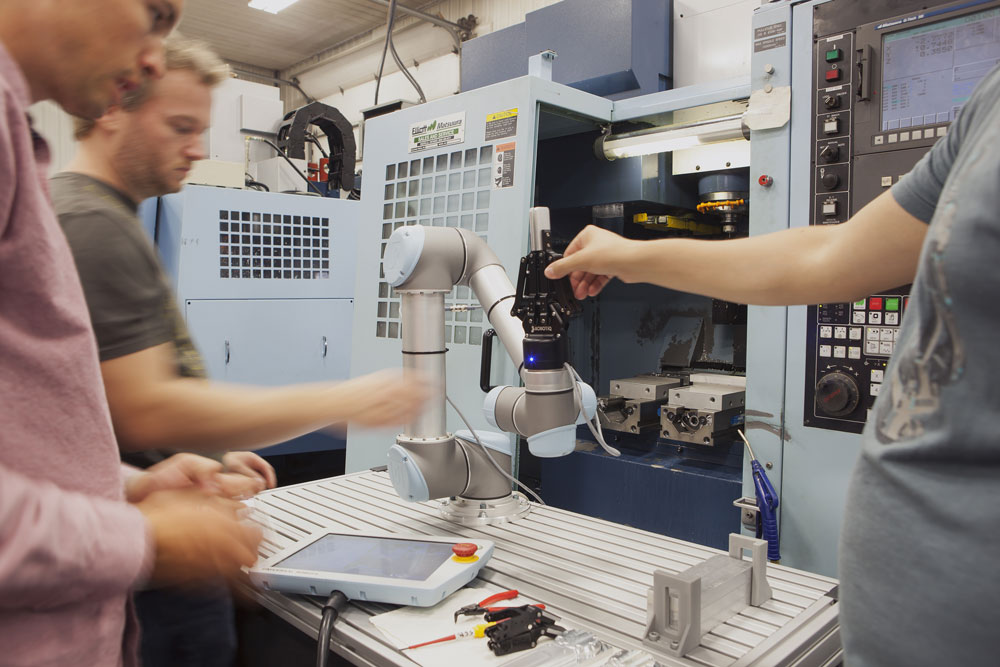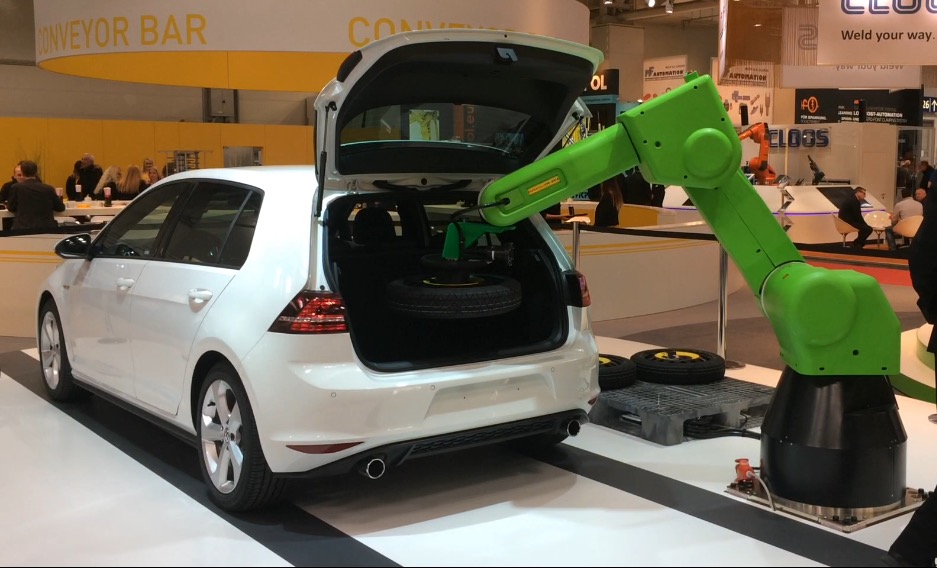
Robohub.org
Key takeaways from #ICRW2015 International Collaborative Robots Workshop
 Everybody agrees that ‘collaborative’ refers to an application, not a robot type. Everyone agrees that there are four types of human-robot collaboration in manufacturing. But in the end, what people at the 2015 International Collaborative Robots Workshop were really interested in are power- and force-limited robots that are easy to use and don’t need guarding.
Everybody agrees that ‘collaborative’ refers to an application, not a robot type. Everyone agrees that there are four types of human-robot collaboration in manufacturing. But in the end, what people at the 2015 International Collaborative Robots Workshop were really interested in are power- and force-limited robots that are easy to use and don’t need guarding.
As usual, safety was one of the main topics in every talk. Once again, everybody agrees: safety is about the application, and you must do a risk assessment. But how? … That’s the big fuzzy open question.
Millennials, manufacturing and collaborative robots
Henrik Christensen from Georgia Tech made the point again that young people entering the workforce have played more than three full years of video games and we should try to leverage this skill set. We should also check which type of console people use nowadays to play; it’s not only about the game controller.
Jim Lawton from Rethink Robotics also mentioned the disinterest of millennials in traditional manufacturing. Easy-to-use and productive robots have the potential to interest younger people with the maker mentality. They could even be interested enough to want to use robots to build stuff as a job.
Collaborative Robots – Vendor Roundup
RIA invited many robot suppliers to present their take on the technology, its applications and market.
Rethink Robotics – The Software Company
Jim Lawton, Technology Executive – Rethink Robotics
Jim Lawton surprised the audience by stating that he works for a software company that makes robots. He explained the usual impetus behind the cobot wave: demography, cost of labor, enabling technologies. Now that we (almost) have safe, cheap and easy-to-use robots, what is coming up? First, Jim underlined the low price or fast ROI of the collaborative robots. He also agrees with the fact that millennials are not interested in manual tasks, and that bringing robots to the manufacturing chain is stimulating for them. Robots such as Baxter and Sawyer work like people do: they can carry human sized parts and do pretty much what a human can do. Finally, he said that robots can adapt to variability through machine learning and that they can be repurposed to a different application quickly.
UR – The Robots of the People
Scott Mabie, General Manager – Americas – Universal Robots
I was wondering about the number of Universal Robots on the market, and Scott Mabie told us that more than 5,000 Universal Robots have been sold so far. It is quite impressive to see how fast collaborative robots are growing. Some major manufacturers such as Maytag even feature the robot in their commercial.
https://youtu.be/zr-BUV8ORTY
ABB – The Volvo of Collaborative Robots
Phil Crowther, Global Product Manager Small Robots – ABB Robotics
If a 3-point safety belt could exist in robotics, ABB would invent it. Crowther presented their rigorous (and complex) approach to safety, which they obviously take very seriously. I could finally play with YuMi in the exhibition area. The booth personnel seemed a little stressed by everybody touching the robot, as if something might go wrong. That is the joy of robots for non-experts! From the little that I saw, it worked perfectly well.
It was the first time I got a look at their clean, user-friendly interface to program the YuMi. Other large end-users who tried it also liked the idea of leveraging the existing know-how of the more powerful and proven ABB tools if they needed to do more complex tasks. Just like Volvo cars, it is a very nice piece of engineering designed with the human in mind. As a gripper manufacturer, I can really appreciate the tight combination of the technology in their arm, the compact packaging of power, air and even embedded vision in the end effector. Crowther also talked a bit about the future of robot teach pendants, where smart phones and cloud computing would take the place of industrial PCs and large pendants. We have an interesting article on this subject by the way.
FANUC – The Lord of Robots
Paul Santi, General Manager – Powertain Systems Group – FANUC America Corporation
FANUC has been a reigning industrial robotics company in North America for years, winning the battle for market share by leveraging solid technology and top system integrators. You can clearly see that the FANUC presentation was colored by their history with their most important customer base: the automotive industry.
I agree with Santi that some things don’t change. You still need reliability and productivity increases. If I take the point of view of most automakers, I also agree that you still need integration for interfacing with machines and controlling the process. Their high payload, full featured, integration heavy approach for their new CR-35iA makes complete sense for the automotive industry. It makes no sense for SMEs who don’t need all the features and can’t get a competitive ROI if they can’t do most of the integration themselves.

Precise Automation – The Underdog
Brian Carlisle, CEO – Precise Automation
I was quite impressed by Precise’s presentation and I really think that they have a great, underestimated potential in the market. One reason is probably because we don’t know them as well as the other players. Carlisle presented the general idea that they are used to making safe robots, and leveraging the intimate knowledge of the physics of robots and software. They now have a very interesting lineup of Linear, SCARA and 6-axis robots. With targeted applications for a low payload (<3 kg), their robots are well suited for parts handling, laboratory automation and other lightweight applications. We have recently featured them in our eBook on Collaborative Robots.
Collaborative Robot User Panel
RIA invited three different collaborative robot users to share their experience in choosing, implementing and leveraging collaborative robots.
GM – The Expert User
Marty Linn, Robotic Principal Engineer – General Motors
Since General Motors was an early adopter of industrial robots (let’s say they almost invented them), you would think that such company would have bunch of collaborative robots working alongside humans to cover all the difficult or redundant tasks. We’re not there yet. In fact, with applications requiring a big payload, it is hard to incorporate a robot with a 5 kg payload to do a heavy task. Another disadvantage of collaborative robots is their relatively small reach. With the new Fanuc CR-35iA, GM is getting one step closer to the introduction of collaborative robots in the automotive industry. They have been testing the CR-35iA for almost a year now in 2 different applications. The fact that the robot can carry heavy parts (up to 35 kg) and has a long reach makes the robot pretty interesting. Compared to SMEs, GM does not need the intuitive programming platform that most collaborative robots are promoting, as they have the in-house knowledge and the repeatability volume to program the robot with standard programming methods. This is why the Green Fanuc is great for them; they are a traditional user.
Glidewell Laboratories – The High Mix / Low Volume Process
Daniel Phee, Mechanical Design Engineer – Glidewell Laboratories
Glidewell Laboratories also shared their experience of using a collaborative robot. Glidewell is manufacturing custom dental crowns in California. With a production of 3,000 to 3,500 crowns per day, they decided to introduce Universal Robots into their process to do the machine tending. Using nine UR robot arms, the company is saving 150 human hours per week. Watch the video to have a better idea of their installation.
Sepcoe Erie – The Job Shop
Chris Pedersen, Operations Manager and Mechanical Engineer, Sepcoe Erie
Chris and his team installed a Universal Robots in a month and a half, got an ROI within 6 months, doubled capacity and reduced scrap by half. Moreover, they improved the workers morale by eliminating a station that was stressful, dirty and highly redundant. That is a great success story on how collaborative robots can increase the productivity of SMEs.
This panel included a wide spectrum of users that illustrated the differences between large and small companies with respect to collaborative robots. GM stuck to their preferred supplier to keep the same programming and interface to resolve ergonomic issues, and smaller companies deployed new platforms on their floors to enhance productivity. Between all these factors the deployment time should also be considered: a few months for the smaller companies; a few years for GM, which needed to do a lot of up front work. For all of them, one concern was employees’ perceptions of the new robots before installation. All agreed that after installation and training, the employees loved the robots that did redundant jobs. That is what collaborative robots are all about.
tags: collaborative robotics, human-robot interaction, RIA






